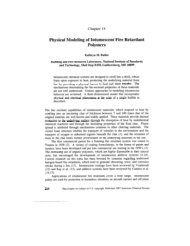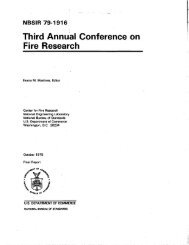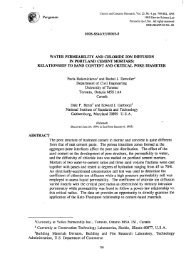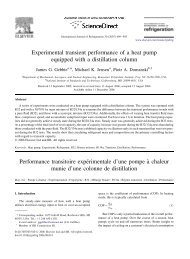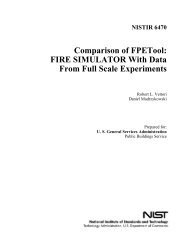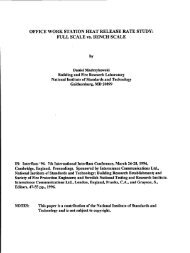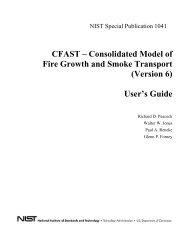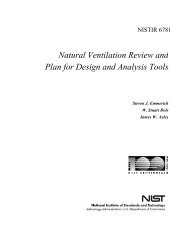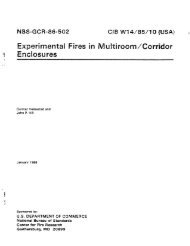Study of Technology for Detecting Pre-Ignition Conditions of ... - NIST
Study of Technology for Detecting Pre-Ignition Conditions of ... - NIST
Study of Technology for Detecting Pre-Ignition Conditions of ... - NIST
You also want an ePaper? Increase the reach of your titles
YUMPU automatically turns print PDFs into web optimized ePapers that Google loves.
PAGE 1 OF<br />
<strong>NIST</strong>-I 14 U.S. DEPARTMENT OF COMMERCE “: “.””’ ‘“” “ “ i~~’~$E’#~~~1’ ‘“ ‘“<br />
(REV. 6-93) NATIONAL INSTITUTE OF STANDARDSAND TECHNOLOGY ‘:fp?4W?yJ<br />
ADMAN 4.09 ,. ,.}:,,’ ‘: ’...<br />
‘PUSL@TfO?& REPORT. SWMBER : ? ‘cfWECWMW COljE<br />
MANUSCRIPT REVIEW AND APPROVAL ,.,..:.,,, .,,,, . ,,;:..,, , , .,,,,,<br />
<strong>NIST</strong>R.5729’: “‘. “’ ‘. “’””:’”’”<br />
tNSTRUCTIONS: ATTACH ORIGINAL OF THtS FORM TO ONE (1) COPY OF MANUSCRIPT AND SEND TO ‘.f@$C+i4TON;Dii~ ~ NUM!3Ef!WRINTED @QES ~.<br />
THE SECRETARY, APPROPRIATE EDITORIAL REVIEW BOARD<br />
‘ibtil?; T$95’ ““ ‘“’‘“ .’ ‘ ““ “:”””. ““’’”’’’’””””’<br />
TITLE AND SUBTITLE (CITE IN FULL)<br />
<strong>Study</strong> <strong>of</strong> <strong>Technology</strong> <strong>for</strong> <strong>Detecting</strong> <strong>Pre</strong>-<strong>Ignition</strong> <strong>Conditions</strong> <strong>of</strong> Cooking-Related Fires Associated with Electric and Gas Ranges and<br />
Cooktops, Phase I I<br />
CONTRACT OR GRANT NUMBER<br />
I<br />
1<br />
TYPE OF REPORT AND/OR PERIOD COVERED<br />
AUTHOR(S) (LAST NAME, FIRST INITIAL, SECOND INITIAL) PERFORMING ORGANIZATION (CHECK (X) ONE BOX)<br />
Johnsson, E. L.<br />
LABORATORY AND DIVISION NAMES IFIRST <strong>NIST</strong> AUTHOR ONLY)<br />
Building and Fire Research Laboratory, Fire Science Division<br />
SPONSORING ORGANIZATION NAME AND COMPLETE ADDRESS (STREET, CITY, STATE, ZIP)<br />
The U. S. Conatmter Product SafetyCommission, 4330 East West Highway, Bethesda,MD 20814<br />
PROPOSED FOR <strong>NIST</strong> PUBLICATION<br />
—<br />
JOURNAL OF RESEARCH (<strong>NIST</strong> JRES)<br />
—<br />
MONOGRAPH (<strong>NIST</strong> MN)<br />
_x_<br />
<strong>NIST</strong>IGAITHERSBURG<br />
<strong>NIST</strong>/BOULDER<br />
JILA/BOULDER<br />
SPECIAL PUBLICATION i<strong>NIST</strong> SP) LIST OF PUBLICATIONS !<strong>NIST</strong> LPI<br />
B<br />
OTHER<br />
TECHNICAL NOTE I<strong>NIST</strong> TN)<br />
x<br />
<strong>NIST</strong> iNTERAGENCY/lNTERNAL REPORT [<strong>NIST</strong>IR)<br />
LETTER CIRCULAR<br />
J. PHYS. & CHEM. REF. DATA (JPCRD) NATL. STD. REF. DATA SERIES (<strong>NIST</strong> NSRDS) BUILDING SCIENCE SERIES<br />
HANDBOOK (<strong>NIST</strong> HB) FEDERAL INF. PROCESS. STDS. [<strong>NIST</strong> FIPS) PRODUCT STANDARDS<br />
PROPOSED FOR NON-<strong>NIST</strong> PUBLICATION ICITE FULLY) Us. FOREIGN PUBLISHING MEDIUM<br />
SUPPLEMENTARY NOTES<br />
B<br />
x<br />
PAPER n CD-ROM<br />
DISKETTE (SPECIFY)<br />
OTHER ISPECIFY)<br />
ABSTRACT (A 2DDD-CHARACTER OR LESS FACTUAL SUMMARY OF MOST SIGNIFICANT INFORMATION. IF DOCUMENT INCLUDES A SIGNIFICANT BIBLIOGRAPHY 01<br />
LITERATURE SURVEY, CITE IT HERE. SPELL OUT ACRONYMS ON FIRST REFERENCE.} (CONTINUE ON SEPARATE PAGE, IF NECESSARY.)<br />
A significant portion <strong>of</strong> residential fires stem from kitchen cooking fires. Existing fire data indkate that cooking fires primarily arc umttended and most <strong>of</strong>ten involw<br />
oil or grease. The purpose <strong>of</strong> this investigation was to ascertain the existence <strong>of</strong> one or more common features or characteristics <strong>of</strong> the prc-ignition environment tha<br />
could be used as input to a sensor in a pr&fire detection devise. The ultimate goal <strong>of</strong> this continuing study is to evaluate the feasibilhy <strong>of</strong> irtcorpomt~o such a devia<br />
into the range thatwould mast to a pre-fire umdhion and reduee the oecttrrenee <strong>of</strong> unwanted kitchen fires. The focus <strong>of</strong> the study was unattended foods placed in pan<br />
on burners set to high heat. Experiments were conducted with three dMferentfoods and with gas and electric ranges to investigate the pre-igrtition environment <strong>of</strong> acttra<br />
range-top cooking tires. Numerous temperatures in the near surroundings as well as local plume velocity and laser attenuation measurements were recorded. A Fourie<br />
--sfo~ infrar&l, FTIR, spectrometer was used to observe significant species production above the fed. Results <strong>of</strong> these experiments arc presented and evaluated<br />
The second part <strong>of</strong> this study was a literature and patent search <strong>of</strong> technologies with the capabiMy to act as either the sensor in a pre-fire detection device or as thI<br />
automatic control that would respond to a detector warning signal by shutting <strong>of</strong>f the gas or electricity supply. A broad range <strong>of</strong> potential detection technologies wcn<br />
reviewed because the pre-fire signatures had not yet been identified. A bibliography and comments on the appticabfhy <strong>of</strong> different technologies are included. ‘III{<br />
conctuaions pertaining to the experiments arc based on measurements and observations <strong>of</strong> combmtions <strong>of</strong> specific ranges, pans, fbods, and ventilation so extmpolatio]<br />
to other conditions should be per<strong>for</strong>med with caution. The major conclusions <strong>of</strong> this =earch are as follows: (1) Strong indkators <strong>of</strong> impcndlng ignition werl<br />
temperatures, smoke particulate% and hydrocarbon gases. (2) Promising detection technologies include tin oxide (SnOJ sensors <strong>for</strong> hydmr=mbondetection, narrow ban{<br />
infrared absorption <strong>for</strong> hydrocarbon detection, scattenqa or attenuation types <strong>of</strong> photoelectric devices <strong>for</strong> smoke particle detection, thermocouples <strong>for</strong> thermometry <strong>of</strong> U-N<br />
burner, pan, range surface (top and below), or range hood. (3) Logieal processing <strong>of</strong> signals from two or more <strong>of</strong> the detection technologies could be an importan<br />
means bv which false alarms <strong>of</strong> me-ignition conditions are etiminatcd. (4) Control technologies exist that arc applicable to the safe shutdown and restart <strong>of</strong> gas am<br />
KEY WORDS 04tAXiMUM OF 9:28 CHARACTERS AND SPACES EACH; SEPARATE WITH SEMICOLONS; ALPHABETIC ORDER: CAPITALIZE ONLY PROPER NAMES)<br />
Iapplianctx fire detection, fire preventio% ignition prevention, kitchen fires; residential buildings; sensors; smoke detectors; stnoke<br />
AVAILABILITY<br />
~<br />
WORDPERFECT<br />
NOTE TO AUTHOR(S): IF YOU DO NOT WISH THIS<br />
UNLIMITED m FOR OFFICIAL DISTRIBUTION -DO NOT RELEASE TO NTtS MANUSCRIPT ANNOUNCED BEFORE PUBLICATION,<br />
ORDER FROM SUPERINTENDENT OF DOCUMENTS, U.S. GPO, WASHtNt3TON, DC 20402 PLEASE CHECK HERE.<br />
ORDER FROM NTIS, SPRINGFIELD, VA 22161<br />
m



